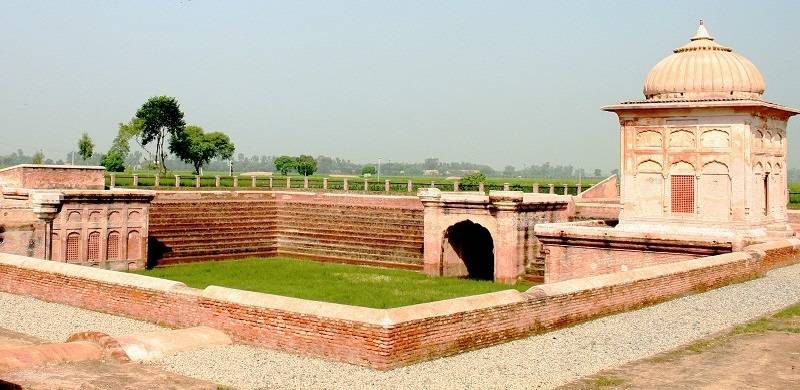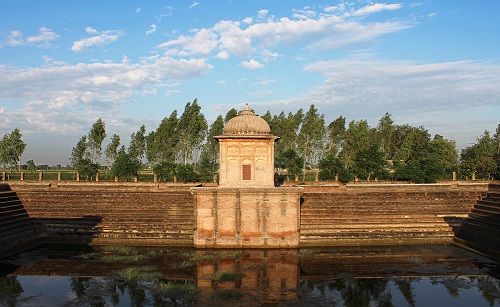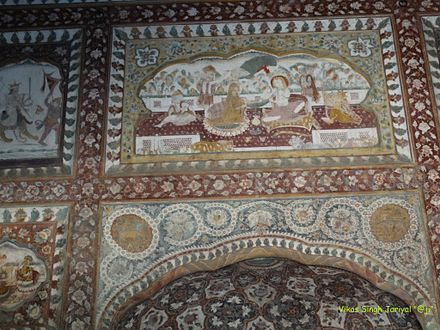
In the long moments that divided a country into two, lives, dreams, families and parchments of history seemed to have been dissolved forever. In a dreadful storm of politics and the separation that followed, parts of land that belonged to the people were lost behind the lines. This is the rich history behind one of those sites. It considers the myth, history and the significant character of the space that was created; and lost forever. If the Taj Mahal stands as a symbol of love for the world, Pul Kanjri has a similar status, if not less, for the people of Punjab. The hauntingly beautiful Pul Kanjri, situated a few kilometers away from the India-Pakistan border at Wagah, has an equally interesting story behind its existence.
Now reduced to a small outpost on the India-Pakistan border, the village in its glory days had much more to offer. It is reported to be an established travel halt frequented by the Maharaja’s expeditions from Lahore to Amritsar and back – and Maharaja here refers to none other than Sher-e-Lahore Ranjit Singh. A ruinous pavilion, a bathing tank, and a trio of a gurudwara, a mosque and a temple bear testimony to the historical significance of the place. Built by Maharaja Ranjit Singh as a bridge on a canal while crossing the Ravi, Pul Kanjri – also called Pul Moran – was built as a symbol of the love that the Maharaja was said to have for Moran Sarkar.
 Moran Sarkar was born in Muslim family at Makhanpure, 5 km from Wahga border, Lahore and 35 km from Amritsar. Moran was a Muslim dancing girl who used to perform for the Maharaja at the “Baradari” (a pavilion constructed for the Maharaja), halfway between Amritsar and Lahore. It is said that once she was unable to cross the canal over Ravi and lost her silver footwear. She later refused to perform for Ranjit Singh, and that is when he decided to build a structure that later became the abode for the star crossed lovers. Pul Kanjri was named as dancing girls were called “Kanjri” in Punjabi.
Moran Sarkar was born in Muslim family at Makhanpure, 5 km from Wahga border, Lahore and 35 km from Amritsar. Moran was a Muslim dancing girl who used to perform for the Maharaja at the “Baradari” (a pavilion constructed for the Maharaja), halfway between Amritsar and Lahore. It is said that once she was unable to cross the canal over Ravi and lost her silver footwear. She later refused to perform for Ranjit Singh, and that is when he decided to build a structure that later became the abode for the star crossed lovers. Pul Kanjri was named as dancing girls were called “Kanjri” in Punjabi.
In her we have the story of one of the most powerful women to have ever lived in Lahore. So impressed was Ranjit Singh by the beauty, skill and learning of Mai Moran, that he decided that once he had established himself as a ruler of Lahore, he would marry her. And so it was that in 1802 he visited her and sought her hand in marriage. A year after he became the Maharajah of Lahore at the age of 21 years, she was officially given the name of "Maharani Sahiba". A gold coin was struck on her name, called "Moran Da Sikka” and hence the people of Lahore started calling her “Moran Sarkar.” She became a window to the common people who often brought their problems to her. She was considered to be very learned in arts and letters. She was known for her philanthropic acts and bringing the Maharajah's attention to many problems.
It was in Lahore that Mai Moran constructed a house for herself in Bazaar Chowk (Pappar Mandi). She requested the Maharajah to get her a beautiful mosque constructed next to her house. The Maharajah at Moran’s request built a mosque called “Masjid-e-Tawaifan,” which was renamed in 1998 as “Mai Moran Masjid” at Pappar Mandi, Lahore. She passed away in 1862 and was buried in Miani Sahib Graveyard near Hazrat Tahir Bandagi’s Dargah. In the bazaar, the house of Mai Moran and her beautiful mosque still stand, testimony to the very intelligent and beautiful woman who once graced it.
 This interesting story also has architectural links. Known for constructing forts, moats and castles, Maharaja Ranjit Singh helped to push many advances in the technology and techniques of building construction. Like his other complexes, Pul Kanjri is admired for its simple design and layout, resilient materials and construction. Like other structures, the bulk of the structure is made of Nanakshahi bricks, having lesser width and thickness, allowing more detailed work to be done. This sets a sandy, dusky hue as the overtone for the place. Fresco details can be seen in the exterior walls also. Maharaja Ranjit Singh, known for his syncretistic outlook, made this space to reflect that attitude too. The complex consists of a Shiva temple, the Sarovar (canal), a Baradari (a pavilion with 12 doors) and a Mosque. Though the Baradari is in ruins now, the other structures have been renovated, and are worth seeing. His structures beamed with character, strength and the symbol of a lasting dynasty.
This interesting story also has architectural links. Known for constructing forts, moats and castles, Maharaja Ranjit Singh helped to push many advances in the technology and techniques of building construction. Like his other complexes, Pul Kanjri is admired for its simple design and layout, resilient materials and construction. Like other structures, the bulk of the structure is made of Nanakshahi bricks, having lesser width and thickness, allowing more detailed work to be done. This sets a sandy, dusky hue as the overtone for the place. Fresco details can be seen in the exterior walls also. Maharaja Ranjit Singh, known for his syncretistic outlook, made this space to reflect that attitude too. The complex consists of a Shiva temple, the Sarovar (canal), a Baradari (a pavilion with 12 doors) and a Mosque. Though the Baradari is in ruins now, the other structures have been renovated, and are worth seeing. His structures beamed with character, strength and the symbol of a lasting dynasty.
Ironically, this space would go on to witness much violence, bloodshed and tragedies associated with the 1947 Partition. Pul Kanjri was captured by the Pakistan Army during the Indo-Pak wars of 1965 and 1971, and was recaptured by the Indian Army later. On 18 December 1971, it was here at Pul Kanjri that Lance Naik (NK) Muhammad Mahfooz of 15 Punjab Regiment heroically dashed at the enemy, laying down his life in the assault. It was a gallant action that would earn him appreciation from the commander of the opposing forces, and the award of Nishan-e-Haider by the Government of Pakistan.
It is the proximity of the place to the border area that has made it a lost part of history. The same soil where people rejoiced together once, got soaked in blood too. Pul Kanjri is truly part of the history of Punjab, and aside from symbolising its complex history, remains a hauntingly beautiful piece of architecture.
Now reduced to a small outpost on the India-Pakistan border, the village in its glory days had much more to offer. It is reported to be an established travel halt frequented by the Maharaja’s expeditions from Lahore to Amritsar and back – and Maharaja here refers to none other than Sher-e-Lahore Ranjit Singh. A ruinous pavilion, a bathing tank, and a trio of a gurudwara, a mosque and a temple bear testimony to the historical significance of the place. Built by Maharaja Ranjit Singh as a bridge on a canal while crossing the Ravi, Pul Kanjri – also called Pul Moran – was built as a symbol of the love that the Maharaja was said to have for Moran Sarkar.
 Moran Sarkar was born in Muslim family at Makhanpure, 5 km from Wahga border, Lahore and 35 km from Amritsar. Moran was a Muslim dancing girl who used to perform for the Maharaja at the “Baradari” (a pavilion constructed for the Maharaja), halfway between Amritsar and Lahore. It is said that once she was unable to cross the canal over Ravi and lost her silver footwear. She later refused to perform for Ranjit Singh, and that is when he decided to build a structure that later became the abode for the star crossed lovers. Pul Kanjri was named as dancing girls were called “Kanjri” in Punjabi.
Moran Sarkar was born in Muslim family at Makhanpure, 5 km from Wahga border, Lahore and 35 km from Amritsar. Moran was a Muslim dancing girl who used to perform for the Maharaja at the “Baradari” (a pavilion constructed for the Maharaja), halfway between Amritsar and Lahore. It is said that once she was unable to cross the canal over Ravi and lost her silver footwear. She later refused to perform for Ranjit Singh, and that is when he decided to build a structure that later became the abode for the star crossed lovers. Pul Kanjri was named as dancing girls were called “Kanjri” in Punjabi.In her we have the story of one of the most powerful women to have ever lived in Lahore. So impressed was Ranjit Singh by the beauty, skill and learning of Mai Moran, that he decided that once he had established himself as a ruler of Lahore, he would marry her. And so it was that in 1802 he visited her and sought her hand in marriage. A year after he became the Maharajah of Lahore at the age of 21 years, she was officially given the name of "Maharani Sahiba". A gold coin was struck on her name, called "Moran Da Sikka” and hence the people of Lahore started calling her “Moran Sarkar.” She became a window to the common people who often brought their problems to her. She was considered to be very learned in arts and letters. She was known for her philanthropic acts and bringing the Maharajah's attention to many problems.
It was in Lahore that Mai Moran constructed a house for herself in Bazaar Chowk (Pappar Mandi). She requested the Maharajah to get her a beautiful mosque constructed next to her house. The Maharajah at Moran’s request built a mosque called “Masjid-e-Tawaifan,” which was renamed in 1998 as “Mai Moran Masjid” at Pappar Mandi, Lahore. She passed away in 1862 and was buried in Miani Sahib Graveyard near Hazrat Tahir Bandagi’s Dargah. In the bazaar, the house of Mai Moran and her beautiful mosque still stand, testimony to the very intelligent and beautiful woman who once graced it.
 This interesting story also has architectural links. Known for constructing forts, moats and castles, Maharaja Ranjit Singh helped to push many advances in the technology and techniques of building construction. Like his other complexes, Pul Kanjri is admired for its simple design and layout, resilient materials and construction. Like other structures, the bulk of the structure is made of Nanakshahi bricks, having lesser width and thickness, allowing more detailed work to be done. This sets a sandy, dusky hue as the overtone for the place. Fresco details can be seen in the exterior walls also. Maharaja Ranjit Singh, known for his syncretistic outlook, made this space to reflect that attitude too. The complex consists of a Shiva temple, the Sarovar (canal), a Baradari (a pavilion with 12 doors) and a Mosque. Though the Baradari is in ruins now, the other structures have been renovated, and are worth seeing. His structures beamed with character, strength and the symbol of a lasting dynasty.
This interesting story also has architectural links. Known for constructing forts, moats and castles, Maharaja Ranjit Singh helped to push many advances in the technology and techniques of building construction. Like his other complexes, Pul Kanjri is admired for its simple design and layout, resilient materials and construction. Like other structures, the bulk of the structure is made of Nanakshahi bricks, having lesser width and thickness, allowing more detailed work to be done. This sets a sandy, dusky hue as the overtone for the place. Fresco details can be seen in the exterior walls also. Maharaja Ranjit Singh, known for his syncretistic outlook, made this space to reflect that attitude too. The complex consists of a Shiva temple, the Sarovar (canal), a Baradari (a pavilion with 12 doors) and a Mosque. Though the Baradari is in ruins now, the other structures have been renovated, and are worth seeing. His structures beamed with character, strength and the symbol of a lasting dynasty.Ironically, this space would go on to witness much violence, bloodshed and tragedies associated with the 1947 Partition. Pul Kanjri was captured by the Pakistan Army during the Indo-Pak wars of 1965 and 1971, and was recaptured by the Indian Army later. On 18 December 1971, it was here at Pul Kanjri that Lance Naik (NK) Muhammad Mahfooz of 15 Punjab Regiment heroically dashed at the enemy, laying down his life in the assault. It was a gallant action that would earn him appreciation from the commander of the opposing forces, and the award of Nishan-e-Haider by the Government of Pakistan.
It is the proximity of the place to the border area that has made it a lost part of history. The same soil where people rejoiced together once, got soaked in blood too. Pul Kanjri is truly part of the history of Punjab, and aside from symbolising its complex history, remains a hauntingly beautiful piece of architecture.

